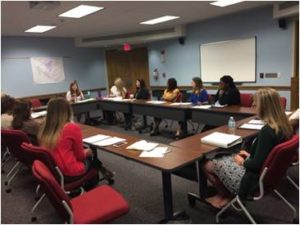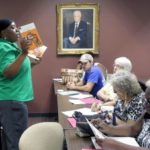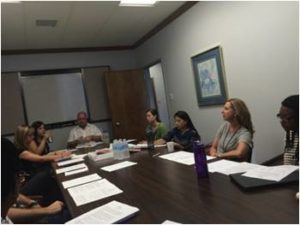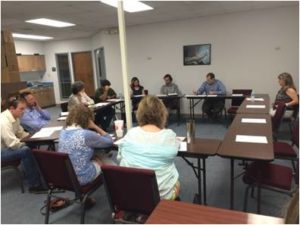By Stephen Swanson
Hey! Psst! Worried about the coming school year? I want to tell you a secret.
Teachers have as much anxiety about the start of the school year as students do. As the weeks and days count off until Fall, we find it harder to sleep as plans run over and over in our minds.
Also, most teachers REALLY want our students to succeed. We look out at each and every student from the littlest pre-k-er to the most mature of non-traditional student in their college classroom and want the very best for you.
Why would THAT make us worry? I’m glad you’ve asked.
Teachers hope to make differences in your lives. However, as much control as teachers seem to have, the vast majority of success in learning boils down to you, the student.
That’s right! The best teachers in the world do not necessarily make differences in every student’s life, and teachers who work the hardest still cannot always provide experiences that fit every student. However, EVERY student can and should take these three major steps to success!:
Think about Priorities and Time
If we could devote all of our time and energy to all aspects of our lives, we’d really have it made. We’d grow into everything we want to become and please everyone who has goals for us. However, trying to do everything usually trips us up. More successful learners identify limits and organize their schedules to match their goals.
In school, time grows more and more scarce. You will probably only have time for school and maybe one or two other priorities. If family matters most to you, then prioritize time with your loved ones.. Want to improve career options? You should learn about those jobs and improve the specific skills needed. Do you value or need work or extracurriculars? Excellent! Do them, and do them well. You can accomplish almost ANYTHING, but you can’t do EVERYTHING. Chose those few priorities wisely. Save the rest of your interests for another time in your life, when you have finished your schooling.
Start managing your time by making a list of EVERYTHING you do and the number of hours you spend on it per week. Don’t forget sleep, eating, chores, taking care of yourself and others, or anything else. Then, subtract those hours from the 168 total hours in a week. How much time do you REALLY have? How much can you take on and perform at your best? We need stress to grow and achieve goals, but too much stress over weeks wears us down physically, emotionally, intellectually, and spiritually.
Challenge yourself
Once you identify your main priorities and the amount of time you have, you need to pick learning opportunities that push you. Many students claim they want challenge, but in their hearts they believe, like Lisa Simpson, “Duh! [I want] A challenge I can do!” Based on this philosophy, they seek out easier classes, teachers who focus on fun, or subjects they already know about. This can feel rewarding to students in the short-term. However, in school you should be preparing yourself for an increasingly uncertain future. With that in mind, you need to develop skills, knowledge, and attitudes that will help you face new challenges.
Educational and psychological experts call these skills “emotional intelligence,” “soft skills,” “grit,” “persistence,” and, “virtue.” Whatever the name, the traits they describe remain remarkably consistent. Students need to engage with new information, connect it to their experiences, and then apply it in new situations they encounter. Sure, we need to think about majors and careers, but careers change more and more quickly. The software you learn in that class will vary from company to company. The policies and procedures will evolve. Jobs will shift and change. You need to know how to change with them. Students need to learn to overcome frustration, confusion, and other roadblocks along the way to accomplishing their important goals.
The good news is that research shows that when we believe we can learn and improve, we make a huge difference in our abilities to learn and improve. Seek out the experiences that challenge and push you to grow into your best self. Don’t accept anything less than experiences that demand the best of you.
Build a Support System
At some point, almost every student feels sad and dejected. Balancing school and work and all the other parts of your life seems impossible! You experience the reality that quality learning takes time and effort. You don’t have much time. You’re really tired. You’re not sure if you can do it or if it’s worth it. It seems like learning comes SO much easier for EVERYONE else. These feelings are not only completely normal but usually show that you actually have begun learning.
Furthermore, I have more good news. You do not need to try to do this alone. At every level of learning, people can help guide and assist you. Seek out and contact those people early and maintain contact.
Start with teachers and counselors. Introduce yourself to them. Share your specific goals and relevant priorities. You don’t need to give everyone your life story, but people can help more when they understand your goals and experiences. Look for potential obstacles and talk about how to work through these challenges and achieve your goals. Ask them for help locating resources for particular gateways that you might need to pass through, and don’t give up if you run into a roadblock or two.
Try to accept some frustration in the process. It can sometimes take a while to find that person to help, but they exist out there. Once you find them, they can help mentor and guide you through a pathway to success.
Education…the kind of education that changes lives…takes effort and struggle. It takes time. As more and more jobs require higher education, and more and more people get degrees and certifications, we need to set priorities, select our challenges, and form a community of people invested in our success. It’s hard. It should be hard, but that doesn’t mean that it’s impossible or that you have to do it alone.
 Dr. Stephen Swanson has only been in Waco since 2009 to teach English and mass communication at McLennan Community College, but also loves playing board games with his family and friends. He can be found at many points around town, wherever people work to make a better Wacotown.
Dr. Stephen Swanson has only been in Waco since 2009 to teach English and mass communication at McLennan Community College, but also loves playing board games with his family and friends. He can be found at many points around town, wherever people work to make a better Wacotown.
The Act Locally Waco blog publishes posts with a connection to these aspirations for Waco. If you are interested in writing for the Act Locally Waco Blog, please email [email protected] for more information.
Photo Credit: “Aqua Negra School Group Portrait”, 1912, Lawrence T. Jones III Texas Photography Collection
(The Heart of Texas P-20 Council includes representatives from K-12 education, higher education and employers. They meet regularly to help coordinate efforts to launch our young people into productive lives as workers and citizens. This post is one in a monthly series of posts intended to share information about the work of this important group in our community. For more posts in this series, click here: P-20 education. )
By Rob Wolaver
It is said that progress does not come without change. That’s certainly the case at Texas State Technical College where we are in the midst of change the college hasn’t seen in its 50-year history. The process is all part of a transition to “single accreditation.” It’s a bold move inspired by economic growth and motivated by industry demand for a skilled workforce.
In the past, TSTC’s four legacy campuses, which ran semi-independently under the direction of TSTC System, would get individually accredited through the Southern Association of Colleges and Schools. Now, we’ll be accredited – reviewed for integrity and quality of student learning – as one college.
It may sound simple but as Chancellor Mike Reeser, who has led the efforts, will tell you, this has been, by far, one of TSTC’s greatest challenges, but one which eventually, could prove to be the zenith of our institution’s storied existence. This change will be remembered as a high point that will lay the foundation for the advancement, development and continued success of TSTC.
Already, we have successfully aligned personnel, programs, curriculum and learning outcomes. We now have a statewide course catalog and student handbook. And, we’ve revamped a consumer-friendly website. TSTC, with 11 campuses total, is now one college serving all of Texas.
It has been a demanding endeavor for the 1,715 employees across the state, and while the job is not finished, we’re well on our way. Now, what does this all mean to you and more importantly, what does this all mean to our TSTC students?
For Texans, One TSTC allows the college to standardize operations and eliminate duplications of work associated with separately accredited colleges. Combining resources will set the stage for expansion of instructional services into communities that need skilled workers or specialized training.
For our students, TSTC is better able serve you. The alignment allows us to better improve classrooms and keep our laboratories stocked with the latest industry tools and technology. Imperative, because we are a hands-on technical school with the goal of making sure you are skilled to start work the day you graduate.
For industry and employers, it means you keep getting technically-skilled workers who can hit the ground running. It means we keep meeting with industry leaders, to make sure our students are well prepared for the jobs at hand. It means we keep doing what we’ve always done best – job placement for the state.
For employees, it means that TSTC will continue to be the best place to work. A place dedicated to its mission of student access and success and its even bigger task of making sure Texas has the employees it desperately needs.
For Texas, this means a stronger economy and lower employment. Indicators of prosperity that benefit every proud resident. It means we continue working with state government and elected officials to make sure we are offering the programs that Texas industry needs and the economy demands.
For Waco, it means that TSTC in your community remains the flagship campus for all the college locations. It means that TSTC will continue to be a partner in education with surrounding ISDs as well as institutions like McLennan College and Baylor University.
The transition to single accreditation is further testament to TSTC’s administrative innovation. Just last year TSTC became the only college in Texas to adopt a funding model based entirely on student employment outcomes. Simply put, we’ll get paid when the student gets paid. TSTC as the saying goes, “putting your money where your mouth is.”
Bottom line, we’re not only investing but doubling down on the communities we serve, that includes Waco, Abilene, Breckenridge, Brownwood, Fort Bend County, Harlingen, Ingleside, Marshall, North Texas, Sweetwater and Williamson County.
As we continue the alignment process, we look forward to the next half century with optimism that our investment will pay off for our students and employers. Ultimately, we recognize that bold leadership and initiative will set the stage for success and the future prosperity of this great state we all call home.
 This Act Locally Waco blog post was written by Rob Wolaver. Rob began his professional career in 1989 at Tarleton State University and left Tarleton in 1992 to become the director of Student Activities and Housing at Texas State Technical College Waco. In the 24 years at TSTC, Rob has served in many leadership roles including, Associate Vice President, Vice President, Executive Vice President, Interim President, Provost. Rob is also active in his community where is on the board of Big Brothers/Big Sisters of Central Texas and chair of the Lorena Economic Development Council. Wolaver has served the City of Lorena as a City Council member and Mayor Pro-Tem.
This Act Locally Waco blog post was written by Rob Wolaver. Rob began his professional career in 1989 at Tarleton State University and left Tarleton in 1992 to become the director of Student Activities and Housing at Texas State Technical College Waco. In the 24 years at TSTC, Rob has served in many leadership roles including, Associate Vice President, Vice President, Executive Vice President, Interim President, Provost. Rob is also active in his community where is on the board of Big Brothers/Big Sisters of Central Texas and chair of the Lorena Economic Development Council. Wolaver has served the City of Lorena as a City Council member and Mayor Pro-Tem.
The Act Locally Waco blog publishes posts with a connection to these aspirations for Waco. If you are interested in writing for the Act Locally Waco Blog, please email [email protected] for more information.
(Para leer este artículo en español, pulse aquí)
By Dr. Cristina Cleveland
When I moved to Waco, coming from Mexico City (the biggest and most populated city in the world), the warmth and kindness from Texans (specifically Wacoans) took me by surprise. As a new mother of twins, overwhelmed just to think about doing groceries, I would find myself standing in the line at HEB stunned by people always trying to help me, either with the babies or with my own bags. At the beginning I found this very odd. Now I feel guilty for those unfriendly looks I gave to people trying to say “I don’t need your help, and stay away from my babies.” With time I found out that is just the way Texans are, welcoming, kind, caring and aware of other people’s needs. That has helped me a lot not to miss my beloved country as much I thought I would.
One of the most funny things that happened to me when I was introduced to new people was the normal and expected question “Where are you from?” (From my strong accent you can figure it out right away I’m an outsider.) I would reply with a big smile on my face “from Mexico!” like it was obvious. Not once, not twice, but many times, I heard the reply, “But, you don’t look Mexican.” I was curious enough to ask, “Where did you think I was from?” The answers were all over the place …Italian, Brazilian, Portuguese, Peruvian, Lebanese and so on … At some point I got a little bit of healthy worry about that.
Why can’t people see immediately that I am from Mexico? The answer is because Mexico has infinite faces.
I will try not to overwhelm you with data, but I would like to share with you why being Mexican, for me, represents being a part of a rich culture more than a race.
Most Mexicans are “mestizos” which means we are a “product” of a mixture between Europeans and Mexican Natives (wrongly called Indians). Most of the European heritage comes from Spain, but remember, Spain was invaded by Muslim Moors from 711 to 1492, and a minority of Muslims persisted until 1609 when they were expelled from Spain. During that period of time they had their own “mestizaje.”
Other European influences to “mestizaje” are Germany, France, Portugal, Italy and Ireland, and even small contributions from Sweden, Poland, Greece, England and Russia. Mestizos also have Jewish heritage since the first colonies were settled in Mexico. There were even some North Africans and Arabs in the mix.
Mexico got its Independence from Spain in 1821, but France invaded Mexico in 1861. The French even named a Mexican Emperor, who, by the way, was never recognized as a legitimate Mexican governor. The French left in 1866. Austrians and Belgians arrived by thousands. Another exodus occurred during the Spanish Civil War from 1936 to 1939, when Spaniards were welcome to rebuild their lives in Mexico.
During the Cold War from 1947 to 1991, Mexico was refuge to many Europeans. Mexico has also been a destination for Mennonites from Canada, Sweden, Germany and Holland. Russians, Scots and Italians have founded their own big towns in Mexico, and the “mestizaje” keeps growing.
Now, let’s come back to Mexican Natives. When the Spaniards arrived they found multiple cultures. The most important were the Mexicas or Aztecas, Perépechas, Zapotecos, Tarahumaras, Otomíes, Seris, Mayos (don’t get confused with Mayas), Lacandones, Olmecas, Tehotihuacanos and Mayas.
I hope by now you are not dizzy trying to figure all this out. We Mexicans have this extremely unique pool of genes, that makes us just unidentifiable in terms of physical features.
There is a Genomic Project developed in Mexico that can show us the exact percentages of our ancestry. But, I don’t want to know how much I am from Spain, Sweden, Teotihuacan or Asia. I identify with Mexico. I was born and raised there, and for most of my life I was surrounded by Mexican culture in language, music, gastronomy, clothes, art and hospitality. That’s why I am proudly Mexican.
So, next time you are introduced to a Mexican, don’t be surprised about their looks, but most important, don’t try to figure it out where their genes are coming from!
 This Act Locally Waco blog post was written by Dr. Cristina Cleveland. Cristina was born and raised in Mexico City. She’s a Pediatric Neurologist and when she moved to Waco back in 2008, she was planning to be a stay-home-mother of their now 7-years-old-twins. Things changed (as usual) and now, after getting a Master’s Degree in Education, she works for the Foreign Language Department in Waco ISD. In her spare time you can see her driving her twins to the library, karate, soccer, swimming and art classes. If she could just get a “time out,” she would probably be walking, swimming, reading or watching a foreign movie.
This Act Locally Waco blog post was written by Dr. Cristina Cleveland. Cristina was born and raised in Mexico City. She’s a Pediatric Neurologist and when she moved to Waco back in 2008, she was planning to be a stay-home-mother of their now 7-years-old-twins. Things changed (as usual) and now, after getting a Master’s Degree in Education, she works for the Foreign Language Department in Waco ISD. In her spare time you can see her driving her twins to the library, karate, soccer, swimming and art classes. If she could just get a “time out,” she would probably be walking, swimming, reading or watching a foreign movie.
The Act Locally Waco blog publishes posts with a connection to these aspirations for Waco. If you are interested in writing for the Act Locally Waco Blog, please email [email protected] for more information.
By Chris McGowan
A downtown Waco renaissance aims to inspire pedestrian activity by creating a concentration of jobs, shopping, entertainment and housing together. Having these activities closer together creates opportunities for walking and builds the kind of community identity that is useful in attracting and retaining businesses and new residents.
The trend toward higher intensity urban development and downtown revitalization in this country has many benefits. Obvious advantages include: higher value land uses, more efficient provision of public services, increased tourism, new restaurants, fun places to shop, great new places to live and opportunities for the community to come together.
Perhaps most important is emerging research that points to America’s post WWII lower density development patterns as a significant contributor to our diminishing health as a nation. A growing body of evidence links increasing rates of diabetes, cancer, obesity, asthma, depression and several other health related problems to community design. Maybe that means the American experiment in community building over the past half a decade or more has made us fat and unhappy.
 Along these lines I remember a discussion with my father-in-law from back when I first moved here eight years ago. He grew up a few miles outside of Waco. We were talking about new things popping up downtown, and he couldn’t help but hearken back to the “good old days” when he was a kid and his family would drive into town. He told me that back then he was sure that downtown Waco was the biggest, grandest place on earth. This conversation inspired him to take a few minutes to walk down Austin Avenue during his lunch hour, grab a hot dog from George’s and remember the way it used to be.
Along these lines I remember a discussion with my father-in-law from back when I first moved here eight years ago. He grew up a few miles outside of Waco. We were talking about new things popping up downtown, and he couldn’t help but hearken back to the “good old days” when he was a kid and his family would drive into town. He told me that back then he was sure that downtown Waco was the biggest, grandest place on earth. This conversation inspired him to take a few minutes to walk down Austin Avenue during his lunch hour, grab a hot dog from George’s and remember the way it used to be.
As he grew up, downtown changed dramatically. At one point in its history downtown was declared “brain dead”, many of the buildings downtown were boarded up, and new transportation infrastructure investments shifted Waco’s center south or southwest three or four miles.
He told me after his walk that while downtown is not as big today as it was back when he was three and a half feet tall, it still has plenty of potential as a great place. I wasn’t around Waco back then but his story inspires me to look at things from a different perspective and to celebrate the great place Waco is becoming.
Next time you have a few minutes to pull yourself away for just a few minutes, do yourself a favor, park your car and take a walk downtown. Discover something new.
Rediscover downtown on a human scale.
After your walk drop us a note and let us know some of the thoughts inspired by your walk as to what you believe downtown Waco can and should be. We look forward to hearing from you. @1000friendswaco.
Interested in the connection between urban design and human happiness? Join us for Act Locally Waco book club at 6:00 on September 14. We’ll be discussing “Happy City: Transforming Our Lives Through Urban Design” by Charles Montgomery. Email [email protected] for info about how to join us.
 This Act Locally Waco blog post is written by Chris McGowan. Chris is the Director of Urban Development at the Greater Waco Chamber of Commerce. At the Chamber, Chris has been responsible for working with the business community, the public sector and other stakeholders to help revitalize our urban core and strengthen the heart of our city. He is husband of Cristi, dad of Ollie, and for fun he is a charcutier. If you even know what that word means, you are probably eating way too much bacon!
This Act Locally Waco blog post is written by Chris McGowan. Chris is the Director of Urban Development at the Greater Waco Chamber of Commerce. At the Chamber, Chris has been responsible for working with the business community, the public sector and other stakeholders to help revitalize our urban core and strengthen the heart of our city. He is husband of Cristi, dad of Ollie, and for fun he is a charcutier. If you even know what that word means, you are probably eating way too much bacon!
The Act Locally Waco blog publishes posts with a connection to these aspirations for Waco. If you are interested in writing for the Act Locally Waco Blog, please email [email protected] for more information.
By Jenuine Poetess
I recently had the pleasure of interviewing Sarah Frances Moran, founder & editor Yellow Chair Review, Waco’s own Art & Literary Journal.
Jenuine Poetess (JP): Tell me about yourself and how you got into writing.
Sarah Frances Moran (SFM): I’m a native Houstonian. I began seriously writing around the age of fifteen. I always had a love for reading and for song lyrics, and my writing came out of a desire to replicate what I enjoyed and also out of desire to express my feelings. You know fifteen-year-olds have lots of feelings.
Without writing I’d probably be in a bad place. Some people sometimes say that it’s therapy and they’re not completely off base. If I didn’t have this outlet I’d have a stockpile of crazy things stored up in my head.
I always kept my writing to myself or to those closest to me. It never occurred to me to put it out there for the public. I have always attended open mic readings and always sat in the back quietly listening. This past September I attended Waco’s Wordfest and most specifically the 100thousand Artists for Change readings. I met ITWOW ([In The Words of Women) Founder Jenuine [Poetess] at that reading and began attending the ITWOW writing group on Monday nights. That outlet opened the door for me to become comfortable sharing my work. I began participating in open mic readings and also began sending out my work for publication. It’s been a crazy year. I’ve had 57 poems (and counting) published in 34 publications. I’ve even dabbled in some memoir writing and have had a few stories published. It’s been a rollercoaster. This venture into the publishing world fueled my desire to start my own literary arts magazine and that’s how Yellow Chair Review came to be.
I could go on for days about setbacks, but they aren’t important. I think it’s important to be resilient, to look ahead and to focus on goals however small or large they are.
JP: How did you get interested in publishing? Tell us about the journey from idea to where you are now?
SFM: I ran a little literary journal when I was in High School that I would send out via email. It was at the dawn of the internet (giving away my age a bit) before blogs and the boom of the online literary world. It was a small email compiled of writing by friends and acquaintances I’d met online. I was also the editor of the school literary magazine. I’ve always had the desire to do that again, and after sending out my own work to a myriad of places I began seeing patterns of things I wanted to do better. I’m certainly under no illusions that I’ve done anything revolutionary with Yellow Chair Review. I simply wanted to create a space for writers and artists that is diverse and approachable. There’s elitism everywhere, and there’s a ton of elitism in the literary world. I don’t want YCR to ever be that.
So I sat down and wrote the pros and cons of doing this (I’m a serious list maker) and determined the pros outweighed the cons. I wanted to make sure this was something I do properly and do in a way that made folks proud to have their work be a part of it.
JP: Where did the name Yellow Chair Review come from?
 SFM: A poem of course! I wrote a poem in high school titled Yellow Chair. It’s a strange poem dealing with some heavy stuff I was going through at the time. I had this long list of name options. It was almost the Olive Ridley Review. I love sea turtles. Iva, my partner in life and with the review, preferred Yellow Chair.
SFM: A poem of course! I wrote a poem in high school titled Yellow Chair. It’s a strange poem dealing with some heavy stuff I was going through at the time. I had this long list of name options. It was almost the Olive Ridley Review. I love sea turtles. Iva, my partner in life and with the review, preferred Yellow Chair.
JP: How is it going compared to your hopes/expectations?
SFM: It is vastly blasting away my hopes/expectations. I thought I’d have to beg for submissions. I thought it would be a slow progression. It has taken off like a rocket. The submissions have been pouring in, and I’ve had to add staff! I never thought I’d have to ask for help. I could definitely be the one to read all of the submissions and do all the work, but I’ve always wanted YCR to be a space that is prompt. One of the things I hate the most about submitting work is the waiting and waiting and waiting. I don’t want submitters to wait long to hear from us. So I’ve enlisted help so that you get that 1-2 day turn around.
JP: What are some future projects/plans you have for YCR?
SFM: We’ve just added two new features to YCR. We’re going to start accepting submissions of Reviews and we’ll start conducting interviews with contributors. The biggest project I’m planning is a Chapbook contest. I don’t have the details etched out 100% yet. I know for sure I want to do a Poetry Chapbook contest. I’d considered also doing a fiction Chapbook contest too, but I don’t know about it yet. More information about that will hopefully be available by September.
JP: Why is it important to you to create an arts & literary journal? What role does it play in the arts community at large and in Waco?

(visual art by Debangana Banerjee; used with permission here and published in YCR, Issue 3)
SFM: I think it’s important to create space. I’ve read a lot of essays and articles about how there are too many literary journals out there and you shouldn’t add to the pile unless you have something extremely unique to bring to the table. I disagree. I think if you’re staying true to the work, to the contributors and doing your best to promote their writing/art you’re doing a huge service to the literary arts community. So many voices go unheard for so many reasons. So create space that helps voices be heard, and do all you can to get those voices out there.
I don’t know that it’s fully doing this yet, but I want YCR to be a space that can say it harbors voices from all over the world, from all walks of life, from all sorts of ideologies, philosophies, races, sexes, orientations, languages etc. Waco itself is more than the majority we see everywhere. I want those underrepresented voices to give YCR the chance to showcase them. Waco has a rich variety of people. YCR can work as a catalyst for those voices.
JP: How can Waco support your work?
SFM: Submitting! I know there are so many poets, writers, and artists in our community, and I would truly love to see their works in YCR. I would love to be able to say that YCR is supportive of the community it’s created in. I can’t say that though if folks don’t give it the chance! So please submit your writings and visual artwork.
Donating! I hate asking for money, but if anyone out there wants to throw donations our way it would be a huge help. Right now YCR is costing my household money, and I don’t mind but it limits what I can do for our contributors. With donations the Chapbook contests can get kickstarted sooner, and we’ll be able to give more in terms of contest winnings. That’s the hugest monetary goal right now. Getting the funds to publish Chapbooks. (You can donate by visiting YCR’s GoFundMe campaign here!)
Reading! Check out the latest issue of YCR via Issuu here.
JP: What else would you like us to know about your work as a poet and as a publisher?
SFM: That I’m here. That I plan to keep myself immersed in this community on a local level and on an international level. That all of our words, our creations, our feelings and thoughts are worthy of having space. That I want to do all that I can to offer that space.
Get Involved!
 To learn more about the submission guidelines and schedule, please click here. To learn more about Sarah and her poetry, please visit her website here. Two blogs to follow are the YCR blog and the Rock the Chair blog, check them out! In September, Sarah will be hosting a workshop on Publishing and Editing at the 2015 WCAF WordFest; join us!
To learn more about the submission guidelines and schedule, please click here. To learn more about Sarah and her poetry, please visit her website here. Two blogs to follow are the YCR blog and the Rock the Chair blog, check them out! In September, Sarah will be hosting a workshop on Publishing and Editing at the 2015 WCAF WordFest; join us!- WordFest Anthology Call for Submissions – accepting entries of poetry and prose now through August 31, 2015. Please visit here for complete details, entry fees, and submission guidelines.
- Central Texas Artist Collective is inviting a statement of intent to participate in the 100 Thousand Artists for Change visual exhibit on Saturday September 26, 2015. Details here.
Waco has a rich array of museums, symphony, theater, community band, arts, and cultural activities. To check out the options, please visit Creative Waco!
 Jenuine Poetess is an artist, visionary, and community organizer. In 2010, she founded In the Words of Womyn (ITWOW), an international, grass-roots, written and spoken-word arts project with chapters throughout Los Angeles, CA; Waco, TX; and Lebanon. Jenuine is the founder of Waco Poets Society and co-founder of the Central Texas Artist Collective. She writes, organizes, and creates rooted in the fierce conviction that holding intentional space, access, and opportunity for all people to foster their creative health is a matter of justice and is a vital asset to the sustainable thriving of communities. She currently lives and poems in Central Texas where she enjoys finding new ways to disrupt the homeostasis of her city. You can contact her at: j[email protected].
Jenuine Poetess is an artist, visionary, and community organizer. In 2010, she founded In the Words of Womyn (ITWOW), an international, grass-roots, written and spoken-word arts project with chapters throughout Los Angeles, CA; Waco, TX; and Lebanon. Jenuine is the founder of Waco Poets Society and co-founder of the Central Texas Artist Collective. She writes, organizes, and creates rooted in the fierce conviction that holding intentional space, access, and opportunity for all people to foster their creative health is a matter of justice and is a vital asset to the sustainable thriving of communities. She currently lives and poems in Central Texas where she enjoys finding new ways to disrupt the homeostasis of her city. You can contact her at: j[email protected].
The Act Locally Waco blog publishes posts with a connection to these aspirations for Waco. If you are interested in writing for the Act Locally Waco Blog, please email [email protected] for more information.
(This blog post is part 2 of a two-part series on Grace House. Grace House is a faith-based recovery home for women in addiction. It is currently Waco’s only long-term recovery home for women. To read Part 1, click here. – ABT)
By Karla Wasion
For over two years I have been serving in a recovery home called Grace House. It has been hard, fun, exciting and exasperating all at the same time. But mostly, it has been one of the greatest learning experiences I have ever had. And I am compelled to share with you what I’ve learned.
Everyone has a story. In the two years I have spent ministering to women in addiction, I’ve heard unimaginable stories. And I’ve learned from them things I don’t know I would have learned any other way.
Parenting.
Almost every addicted woman I have encountered was either parented badly, or not at all. Mothers have told their daughters they wish they had never been born. Fathers and step-fathers have used their little girls as sexual toys. They have endured trauma that most of us could never fathom surviving. The most horrific aside, these women rarely heard the words “I love you” or “I’m proud of you”. They were not told they were beautiful or valuable. They were chastised for being fat and had food withheld from them.
 What does a little girl do when she has been taught that she has no value other than her body? What does she do with all of that emotional pain that comes from so much abuse and neglect? She uses her body to survive, and she fills it with whatever will numb the pain and the self-hatred. She becomes the women I have had the privilege of walking with for two years.
What does a little girl do when she has been taught that she has no value other than her body? What does she do with all of that emotional pain that comes from so much abuse and neglect? She uses her body to survive, and she fills it with whatever will numb the pain and the self-hatred. She becomes the women I have had the privilege of walking with for two years.
I’ve learned that parents have an enormous impact on their children. I’ve learned up close the value of telling a child that they are beautiful, wanted and loved. And I’ve learned the impact of parents who do the opposite. I have become more grateful for my own parents who, though flawed themselves, never let me be unloved or unwanted. Though my own story has not been a fairy tale, I am thankful for it now more than ever.
Relapse.
It is part of the addiction recovery process. Prior to this ministry, I would have thought of relapse as failure, or just rebellion. In my own arrogance, I would have written them off. And I would have been so wrong. Relapse is simply an indicator that deeper healing is needed. The pain these women have runs far deeper than most us can imagine, and reactions to that pain are ingrained. I’ve learned that Jesus doesn’t panic over a relapse and neither should I. When a woman returns in repentance and humility, her healing process can continue and her testimony becomes even stronger. I’ve learned about God’s grace through watching women relapse. His grace for them, and His grace for me. Because my own life is not without relapse. I too return to familiar ways when pain becomes greater than I can handle in the moment. I have learned that I am as much in need of grace as anyone, and I have learned from these women how to come back to the Father with humility and accept the grace He so freely offers.
And what of those who do not return? I’ve learned that a woman can truly love Jesus and want to live for Him, but be so afraid of the pain that recovery exposes, that she simply cannot bring herself to return to the process. So I’ve had to learn to let go, knowing that Jesus never will. He will go after them because He loves them and wants their freedom even more than they do. His grace and mercy do not stop at the door of a recovery home, but continues to follow them. I’ve learned that their destiny is in His hands, not mine, so I can loosen my grip because I know that He will not loosen His.
The Father’s voice.
Lies are the glue that holds a stronghold together. I’ve seen and heard the effects of a woman who believes the lie that she is worthless. And I’ve learned that it is not my truth that will set her free. It is the truth spoken to her by her Father that brings a stronghold down. Whether a woman has known Jesus for a year, or for an hour, she can hear the voice of God. I would have doubted that two years ago, thinking that hearing His voice requires maturity. Rubbish. For two years I have spoken truth to women and while it may have brought some relief, it is the loving voice of God that has brought true change. And I’ve learned that I can receive revelation from a broken woman who has heard her Father speak truth. But mostly, I’ve learned that there is just no substitute for hearing my Father speak truth over me to break the power of lies I have believed.
Compassion.
 I’ve taken those spiritual gifts tests many times. Every time I’ve taken such a test, it has revealed the same exact thing. My top three gifts have always been the same, and so have my bottom two. I have consistently scored a zero, yes, a zero, in the gifts of Mercy and Compassion. And so I have learned that sometimes God will put you in a place specifically designed to give you what you lack. And I’ve learned that it is not easy to become more like Jesus, especially if you have a big fat zero looming over you. But that’s just it. It isn’t my mercy or my compassion that anyone needs, it’s His. And so I’ve had to learn to ask, over and over, for Him to give me His compassion in the moments when I just don’t have it. When I have been frustrated with someone and wanted to just turn and walk away, He has been faithful to saturate my heart with compassion that compels me to stay, to listen, to understand.
I’ve taken those spiritual gifts tests many times. Every time I’ve taken such a test, it has revealed the same exact thing. My top three gifts have always been the same, and so have my bottom two. I have consistently scored a zero, yes, a zero, in the gifts of Mercy and Compassion. And so I have learned that sometimes God will put you in a place specifically designed to give you what you lack. And I’ve learned that it is not easy to become more like Jesus, especially if you have a big fat zero looming over you. But that’s just it. It isn’t my mercy or my compassion that anyone needs, it’s His. And so I’ve had to learn to ask, over and over, for Him to give me His compassion in the moments when I just don’t have it. When I have been frustrated with someone and wanted to just turn and walk away, He has been faithful to saturate my heart with compassion that compels me to stay, to listen, to understand.
I’ve learned that my zero means Jesus is always the hero. (How cheesy was that?!)
Serving.
Nothing has shown me the value of serving more than this ministry. Without the people who volunteer their time, energy and finances, this ministry would not exist. I’ve seen members of this community of believers, and the Body of Christ at large, give of themselves in extraordinary and selfless ways. Before now, I had been seeing a discouraging trend in the Church, of people only willing to serve if they will get paid. I’ve heard people excuse this trend by talking about how valuable everyone’s time is and that people should not be expected to serve for free. (Yep. Really heard that.) But I’ve watched and I’ve learned that not everyone feels that way. Here, I’ve seen people give up what is so valuable to them for the sake of the Kingdom and the work God is doing, and they give it up willingly and with joy. So I’ve learned that serving is not something that we should be reluctant about, nor does it need to simply be a ‘duty’. It is vital to the health of every ministry, and to the Church. I cannot express how important the service of those who give to this ministry has been, and how encouraging it is to see people want to give up what is valuable for what is better. Watching them has inspired me to want to be a better servant of God.
Missions.
It took a while for me to understand that I was actually on the mission field, and these women were part of God’s harvest. I, like many, considered missions as being somewhere else, somewhere ‘over there’ in a third world country. It isn’t. I’ve learned that being a missionary doesn’t require a plane ride or going to the bathroom in a hole in the ground. It is simply going where God is calling you and doing what He is calling you to do. My mission field is five minutes from home, but I am still a missionary. Laying down your life can happen a mile from home or five thousand miles from home. So I have learned to pray for missionaries regardless of where they are serving, because I have needed so much prayer in this mission field.
There’s so much more. I could go on for days about what God has done in me and taught me in the last two years. Ministering to the broken is hard in every way, but I’ve seen what is harder. Going through the pain of recovery.
To every woman I have encountered in this journey, I tip my hat to you. The rest of the world may not know it, but I know how brave you are. I know how much courage it has taken to keep walking out of bondage. I know how many tears you’ve cried and how hard it has been having to remember things you’ve wanted to forget. I know the fight you have put up when everything in you has wanted to run and hide and numb again when it all got too hard. I have witnessed the depth of the shame you have lain at His feet and the effort it has taken to hold your head up. I know your story and I am so very proud of you for allowing Jesus to have it and to turn it into something that will bring Him glory.
But my knowing all of that is not the best part. Your Father knows all of that and more. He knows all the parts that are just yours and His. Your Father is proud of you. He is for you and with you and in you. He has a destiny for you that you never thought possible. You are loved beyond measure! Don’t give up!
 This blog post was written by Karla Wasion. Karla has been a blogger since 2009 and has been on staff with Grace House since 2013. She is currently writing her first book detailing the story of the restoration of her marriage. She and her husband moved to Waco in 2012 from the Chicago suburbs to be closer to their two adult children. Her first grandchild was born in June, and her second one is due in November, so it’s been a big year! You can visit her at www.outofedenministries.com. The ladies at Grace House are desperate for change, but they need help getting there. This ministry is not possible without community partners like you. Please visit our website www.gracehousewaco.com for more information or to make a donation.
This blog post was written by Karla Wasion. Karla has been a blogger since 2009 and has been on staff with Grace House since 2013. She is currently writing her first book detailing the story of the restoration of her marriage. She and her husband moved to Waco in 2012 from the Chicago suburbs to be closer to their two adult children. Her first grandchild was born in June, and her second one is due in November, so it’s been a big year! You can visit her at www.outofedenministries.com. The ladies at Grace House are desperate for change, but they need help getting there. This ministry is not possible without community partners like you. Please visit our website www.gracehousewaco.com for more information or to make a donation.
The Act Locally Waco blog publishes posts with a connection to these aspirations for Waco. If you are interested in writing for the Act Locally Waco Blog, please email [email protected] for more information.
By Matthew Polk
Prosper Waco has picked up momentum over the last several weeks! The Prosper Waco Board of Directors ratified the measurable goals developed by the three Steering Committees, and working groups focused on each of the goals have begun meeting to develop collaborative strategies for achieving them.
These working groups, centered on each of the Education, Health, and Financial Security goals, serve as a venue for partners to dialogue about strategies that can move our community forward. This is the nitty-gritty—community members coming together to sit down and dive deep into conversations that will lead to implementable strategies.
Each working group has met at least once in the past couple of weeks. Working groups will continue to meet over the next two months. Then, in October, each group will present the strategies they have developed to their Steering Committee.
Here is a quick update on the progress of each working group. For full minutes from each working group and a calendar of working group meetings, please visit our website.
Education
Kindergarten Readiness: Members of this working group are focusing on increasing the percentage of kindergarten-ready students in our community. Numerous early childhood organizations were represented in this meeting. Dr. Mary Konrad, Early Childhood Education Coordinator for Waco ISD, spoke about the pre-K assessment that the district uses to assess each child’s readiness to succeed in Kindergarten. Members discussed ways to align their work around the school readiness components identified by WISD and created a list of key partners in the Waco community whose work impacts the success of children as they enter school.
Post-Secondary Success: Members are focused on doubling the percentage of economically-disadvantaged students who complete a workforce certificate or college degree. The discussion of the definition of workforce certificate was discussed, and various resources were distributed to the group so that a collective definition could be agreed upon at the next meeting. The group also compiled a list of additional partners needed to drive a community-wide approach to post-secondary success.
Family Engagement: Although there is not a measurable goal directly related to this working group, the Education Steering Committee recognized from the outset that family engagement is a priority issue for improving education in our community. Molly Young, Waco ISD’s Director of Community Development, is the chair of this group. In its last meeting, group members discussed different strategies to best engage families in the educational process and how to connect Waco families to community resources.
Health
Access to Care: The goals for this working group are to the increase percentage of people covered by health insurance by at least 1 percent per year and to decrease the percentage of people utilizing the ER as a source of primary care by 10 percent. Like the Obesity and Women’s Health working groups, the Access to Care working group has been active for the last couple of years as part of the Community Health Improvement Plan (CHIP) committee, one of the initiatives that laid the foundation for Prosper Waco.
Obesity: This working group discussed strategies around high, medium and low impact ways to reduce obesity among Waco residents and how to best utilize the resources that are already in place. For example, a strategy to increase activity levels in adults and children is to use the joint-use agreement (JUA) facilities around the Waco community that are available to residents. Also, the strategy of an active living plan based on evidence-based strategies for ways residents can become active and lead healthier lifestyles was a main topic of conversation.

Women’s Health working group meets to discuss what other organizations should be included in their meetings.
Women’s Health: Members of the women’s health group are thoughtfully considering how best to collect data to drive evidence-based strategies for meeting their goals. The group agreed to look at what other communities have done in terms of programs to reduce disparities of poor birth outcomes, increase the percentage of women receiving annual preventive care, and reduce the rate of teen pregnancy across all racial groups.
Mental Health: A variety of mental health professionals attended this meeting. Existing mental health resources were identified, and the group discussed other strategies targeted at decreasing use of local emergency rooms for mental health treatment and improving the “poor mental health days” component of the Robert Wood Johnson Foundation’s County Health Rankings to the Texas average.
Financial Security
Employment: We had a great turn out at this meeting. During the first meeting, members spoke about who else from the community should be included to add depth to the working group. Dialogue focused on what strategies would increase employment of Waco residents ages 16-24, with the goal of cutting unemployment of this group by half over the next five years.
Income: The income working group is focused on connecting Waco-area residents to job training and employment opportunities in order to increase the median income of people living in our community with a focus on those earning the least. The group’s discussion focused on how to build a pipeline that would effectively connect workers to employers so that opportunities for earning more income are available to more people in the community and employers benefit from a more skilled workforce.
Wealth: Helping our community build wealth means helping more families build a foundation for financial security in their lives. This starts with providing people in our community access to tools and information for managing their money and building savings that will get them through financial ups and downs. For others, building wealth means moving toward homeownership or investing in others assets that will improve their family’s net worth and financial security.
Typically, working groups meet twice a month based on the best available time for the members. You can check the calendar on our website for a list of all past and upcoming meetings! Working groups are open to all community members, regardless of your expertise in the three impact areas. Having different perspectives from community members at the working group meetings will lead to better, well-rounded strategies that will positively impact a broader range of Waco residents.
We know there are many people in the community who want to be part of the Prosper Waco initiative but cannot meet during the day due to their jobs or other responsibilities. We understand this and are working to figure out an evening time that works best for community members to be part of the discussion about meeting our shared goals.
To become involved in a working group, please email our Community Engagement Coordinator, Jillian, at [email protected], or call her at 254-741-0081. Get involved in this community-wide initiative and have a positive impact on your community!
 This Act Locally Waco Blog post was written by Matthew Polk. Matthew is Executive Director of Prosper Waco. Prior to that, he served as Superintendent of Rapoport Academy Public School. He and his wife attended Baylor, and after spending a few years in the northeast, they returned to Waco to raise their family. They have four children, ages 8 to 3 months. You can contact him at [email protected].
This Act Locally Waco Blog post was written by Matthew Polk. Matthew is Executive Director of Prosper Waco. Prior to that, he served as Superintendent of Rapoport Academy Public School. He and his wife attended Baylor, and after spending a few years in the northeast, they returned to Waco to raise their family. They have four children, ages 8 to 3 months. You can contact him at [email protected].
The Act Locally Waco blog publishes posts with a connection to these aspirations for Waco. If you are interested in writing for the Act Locally Waco Blog, please email [email protected] for more information.
by Meilana Charles
With the weather in McLennan County regularly reaching 90 degrees or higher, staying hydrated is essential. Unfortunately for many people staying hydrated means the overconsumption of fruit juices or drinking sugary-carbonated beverages because water may lack a desired flavor.
Well, there’s a simple solution: Infused Water.
Infused Water is the combination of water with fresh fruits and herbs. For the past year I’ve been hooked on Infused Water. I’ve discussed the different recipes I’ve tried informally with several local groups, and I even created a mini-program about the benefits of drinking infused water that was presented at Restoration Haven, a local community ministry located in the Estella Maxey Public Housing complex, last year. Even children at several summer day camps have noticed the “leaves” (mint) floating around in my water.
I can’t take all the credit for my yummy discovery. Infused Water has been used as a refreshing drink in several cultures. According to Basu (2014), Infused Water may be a derivative of Aguas Frescas, a flavored drink popular in the Caribbean and in Central and South American countries.
Not only is Infused Water refreshing, it’s also healthy. Danielle Hairston-Greene, a Program Specialist with the Cooperative Extension Program wrote in her “What’s on My Plate” blog that, “There are many health benefits of infused water including appetite control, hydration, immune defense, heartburn prevention, blood sugar regulation and weight management.” Hairston-Greene even provided several combinations with their specific health benefits.
 Preparation of Infused Water is relatively easy. Once you decide which recipe to use simply cut up the fruit than use a fruit squeezer to extract the juice leaving the pulp. Next, add the juice to filtered water than let it sit overnight. I personalize my creations with fresh Ginger Root and Mint.
Preparation of Infused Water is relatively easy. Once you decide which recipe to use simply cut up the fruit than use a fruit squeezer to extract the juice leaving the pulp. Next, add the juice to filtered water than let it sit overnight. I personalize my creations with fresh Ginger Root and Mint.
Alternatively, some people prefer to cut up their fruits and add then them to the water. Infusion water bottles are also popular.
So the next time the Texas summer heat has you thirsty, pass on the soda, skip the sugar and use your imagination to think up a refreshing and nourishing Infused Water recipe for you and your family to fall in love with.
 This Act Locally Waco blog post was written by Meilana Charles. Meilana is a Family and Consumer Sciences Extension Agent at Cooperative Extension Program at Prairie View A&M University. Meilana’s priority areas for providing educational resources to McLennan County are general nutrition, money management and parenting. She has a M.S. in Child Development from Texas Woman’s University and is a certified Human Development and Family Studies professional through American Association of Family and Consumer Sciences.
This Act Locally Waco blog post was written by Meilana Charles. Meilana is a Family and Consumer Sciences Extension Agent at Cooperative Extension Program at Prairie View A&M University. Meilana’s priority areas for providing educational resources to McLennan County are general nutrition, money management and parenting. She has a M.S. in Child Development from Texas Woman’s University and is a certified Human Development and Family Studies professional through American Association of Family and Consumer Sciences.
The Act Locally Waco blog publishes posts with a connection to these aspirations for Waco. If you are interested in writing for the Act Locally Waco Blog, please email [email protected] for more information.
Sources:
- Basu, B. D. (2014). Beat the Heat by Gulping Fruit Infused Water Drink. Positive Health,(218),
- Hairston-Greene, D. (2014) The Health Benefits of Infused Water. What’s on My Plate blog.
(This blog post is part 1 of a two-part series on Grace House. Grace House is a faith-based recovery home for women in addiction. It is currently Waco’s only long-term recovery home for women. Part 2 will be posted next Sunday. – ABT)
By Mary Burt
Three weeks before I walked through the doors of Grace House was the last time I tried to take my life.
I remember waking up the next morning with my head pounding, lying on a dirty mattress splattered with old blood and vomit, and thinking to myself, “God is not letting me die.” Somewhere deep inside I found the faith to utter this desperate prayer, “God if you won’t let me die, you have to show me how to live.” Though I had received short-term treatment in the past, I hadn’t been ready to deal with the fear and pain that filled my heart. After a decade of using alcohol and other substances to numb the pain and quiet my fears, I was on death’s doorstep and really ready for a change. I was ready for a chance to live.
For me, abusing substances wasn’t just a way to have a good time, it was a way to survive. My parents got divorced when I was about three years old, leaving my Dad with three kids under the age of four. A few years later, my siblings and I moved in with my mom and our new step-Dad. With a large family to support, my mom started working nights, leaving my step-Dad as the primary parent most days. My step-Dad became verbally abusive, which soon evolved into physical and sexual abuse that lasted, off and on, for about 10 years.
By the time I was 10 years old, deep depression drove me to search for anything that could ease my pain. I started physically harming myself after getting the idea from a TV show. When the cuts and scars on my body weren’t enough, I started looking to pills and alcohol. I remember the complete relief I felt the first time I got drunk when my whole body, mind and emotions went numb. I thought that was how I was going to make it, and over the next 10 years, my life spiraled into a blur of addiction and escape.
Then I came to Grace House.
In John 10:10 Jesus says “The thief comes only to steal, kill and destroy; I have come that they may have life, and have it to the full.”
It wasn’t until I witnessed genuine love expressed through the staff and volunteers of Grace House that I realized what having “full life” really was. Although it was challenging and scary at first, I was willing to change and as I let go of worldly independence, it felt like parts of me were dying day by day.
The more I said yes to God and to the staff in the house, the more I experienced true love and freedom.
 During my time in Grace House, love looked like women believing in me before I was able to believe in myself and relentlessly pursuing me, even on my worst days. There were days I would shut down and sit in silence for long periods of time, lie about my feelings, walk away from authority, and say one thing, then do the opposite. The pain inside just made me want to run; run far from love, from truth, from hope.
During my time in Grace House, love looked like women believing in me before I was able to believe in myself and relentlessly pursuing me, even on my worst days. There were days I would shut down and sit in silence for long periods of time, lie about my feelings, walk away from authority, and say one thing, then do the opposite. The pain inside just made me want to run; run far from love, from truth, from hope.
But when I finally began to let others in, I discovered that there really was a place of belonging for me. In the midst of my pain, sadness and loneliness, I had been rescued and settled in a safe place with a new family and with a Father that knew my name. Grace House paved the way for freedom and real healing for me by sticking with me, asking genuine questions and accepting me despite my past. In His mercy, He placed me in this home filled with compassion and love. I now know that I am worth so much that Jesus died in order for me to live, that He has a plan and a purpose for me and that I will never be alone.
A Night with Grace House
Grace House is a faith-based recovery home for women in addiction. It is currently Waco’s only long-term recovery home for women. With a family style approach, the home is able to provide care for up to six women free of charge. The desire of Grace House is to see women holistically healed from chronic addiction and restored through relationship with Jesus Christ.
On August 13th, 2015, Grace House is hosting A Night With Grace House to raise funds in order to re-open the home for more women. If you were stirred by this story, please consider giving and attending the event. To purchase tickets and for more information, please visit www.gracehousewaco.com.
 This Act Locally Waco blog post was written by Mary Burt. Mary is a former Grace House resident. Since graduating from Grace House, Mary has gone through Antioch Discipleship School and is now on the maintenance, serves as a house manager for one of Antioch’s missionary guest homes and volunteers with Grace House.
This Act Locally Waco blog post was written by Mary Burt. Mary is a former Grace House resident. Since graduating from Grace House, Mary has gone through Antioch Discipleship School and is now on the maintenance, serves as a house manager for one of Antioch’s missionary guest homes and volunteers with Grace House.
The Act Locally Waco blog publishes posts with a connection to these aspirations for Waco. If you are interested in writing for the Act Locally Waco Blog, please email [email protected] for more information.
By Phil York
Summer is my favorite season and the 4th of July is one of my favorite holidays. As a Navy brat, I shared many 4ths with other military families under an illuminated Washington, D.C. night sky; the glow of each explosion brilliantly reflected off of the marble monuments and served as bright dramatic reminders of the sacrifice many service members and their families pay for our freedom.
This past 4th, many of us may have traveled far and near to be with friends and family. We can all agree on one thing: there is nothing like returning home.
As we learned from our previous discussions in our housing blog series, many of our brothers and sisters here in Waco do not have safe, decent and affordable places to call home. Several local nonprofits work diligently alongside the dedicated staff members of the City of Waco and hard-working first time homebuyers to make the American Dream of homeownership a reality.
These efforts depend on HOME funds. Appropriately named, “HOME” is a federal program. Its longer name is “The HOME Investment Partnership Program.” HOME funds are appropriated to local jurisdictions, such as the City of Waco, so that organizations like Waco Habitat for Humanity can build a stronger Waco. These funds can be spent towards new construction, infrastructure improvements and repairs.
Drastic cuts in the HOME program are currently proposed. The latest policy updates from D.C. report that the Senate appropriations proposed to cut the HOME program by 93%. This is a cut from $950 million to $66 million. This will essentially eliminate the HOME program at a time when the need for affordable housing is growing across our nation. The United States Conference of Mayors December 2014 report “shows that 48% of the surveyed cities experienced an increase in homelessness. The report identifies a lack of affordable housing as the leading cause of homelessness among families with children.”
Affordable housing is defined as that which does not require a household to spend more than 30% of gross annual income. The National Low Income Housing Coalition reports in 2013 that the fair market rent for a two bedroom apartment in Texas is $847. In order to afford this level of rent without paying 30% of income, a household needs to make $34,671 annually. The median income in the Waco Area is $32,239 compared to the $51,900 state-wide; affordable housing is a need in our community.
Why the Cut?
We understand that our law makers have a duty to balance the budget and to make sure budget funds are spent wisely, and the HOME program has come under some harsh criticism. A 2011 Washington Post investigation launched a probe into the misuse of HOME funds. The article reported startling misuse of HOME funds: “hundreds of millions of dollars squandered on abandoned projects ; 700 projects with $400 million left idle for years; abuse was seen across the nation in communities such as Inglewood, California, Newark New Jersey, and Orange, TX.”
These reports are undoubtedly disturbing, but as with all policy discussions, it is important to have a balanced view on an issue. Misuse of some program funds by some agencies may mean those agencies need to be re-organized, it does not necessarily mean that a whole program needs to be defunded.
HOME funds accomplish exactly what they are meant to accomplish in many communities – for example, Waco!
HOME Here in Waco:
On-time Construction timelines, completed construction production numbers and experienced staff preserve the integrity of the HOME program here locally. Here in Waco organizations that use these funds go through annual on-site audits. They build based on a stringent federal and local building codes. And they partner with applicants that are financially ready for the obligation of a 25-30 year mortgage. Staff members attend continuing education in construction, management and loan origination best practices. Each year, Waco’s organizations have to apply for funding and prove that they are worthy of another year of support based on the previous year’s performance.
The reality of how HOME funds are managed here in Waco is in sharp contrast to the 2011 Washington Post investigation. Here in Waco, precious tax payer funds are managed with the highest due diligence by both CHDOs and City of Waco leadership.
How I was Welcomed HOME
This past week, I was blessed to visit a Habitat homeowner with two members of my board (names have been changed to protect privacy). Sarah greeted us to her home. The purpose of our visit was to share the Star Garden Award; a program our board shares with the best of the best lawns in our Habitat communities.
Sarah greeted us from her driveway with a warm smile and a high-energy wave. Her hospitality beamed nonstop for the next hour. She proudly took us on a tour of her home. Sarah showed us the swing set she installed for her 6 year old daughter, Abigale. Sarah said Abigale can now invite friends over to play. The neighborhood is safe. The home is something her child is proud of. The swing set is lined with beautiful brick pavers she bought from the Habitat ReStore.
Sarah said something that stuck with me. “I literally helped to build this house through my own hands,” she said. “I continue to use those skills not only around the house but also outside with projects like these. I feel an independence that I never felt before in my life…this is our home…a place my Abigale will have long after I am gone.”
Sarah’s home was partially funded with HOME funding. HOME allowed Sarah to realize the independence of the American dream. But Sarah reminded me that her homeownership has a multi-generational impact in our community. Abigale happily swung on the swing set and sang a happy tune while Sarah continued to smile non-stop during her reflection of her home buying process. Sarah and Abigale embody the purpose of the HOME program.
CALL TO ACTION
There are many ways to let your voice be heard so that more homeowners like Sarah may realize the hard-earned status of homeownership.
Next time you are on social media, simply copy and paste the language below into your favorite social media outlet.
Tweet:
Americans are struggling more than ever to afford rising housing costs #UseYourVoice to tell Congress to #SaveHome! http://bit.ly/HFHHOME
Facebook:
Don’t let Congress cut funding for HOME, an efficient and effective program that helps Habitat provide affordable housing for those who need it most. Use your voice today to save HOME: http://bit.ly/HFHHOME
Speak Directly to your Elected Officials
Find your representative with this link. You can type in your zip code and your representatives will appear: http://www.fyi.legis.state.tx.us/Zip.aspx
Do not hesitate to contact all of the officials that represent you; federal, state and local.
GO here to learn of your City of Waco Council representation:
http://www.waco-texas.com/district-map.asp
Use information from this blog post as you speak to your representative. Here are some more talking points:
Production Numbers of the HOME Program (HOME Advocacy Coalition):
- Every $1 million in HOME funds creates or preserves approximately 18 jobs.
- Since 1992, HOME has created more than 1 million affordable homes
- 496,000 homes for new homebuyers
- 232,000 owner-occupied homes repaired
- 298,000 tenants received direct rental assistance
- More than half of HOME Funds have been used to assist “very” and “extremely” low-income families.
Get Involved
These are the websites of nonprofit builders (CHDOs) in Waco that build alongside the City of Waco. Ask to get involved, volunteer or to give to their powerful missions.
- Waco Habitat for Humanity – https://www.wacohabitat.org/
- NeighborWorks Waco – https://www.nw-waco.org/
- Waco Community Development Corporation – http://wacocdc.org/
When the glow of sparklers fade, when the last plume of BBQ smoke disappears with the last of summer’s warm, lazy nights we will all be asked that annual question: “what did you do this summer?”
With these easy action steps, we will be able to say that we helped to preserve HOME not only for our nation, but for our community right here in Waco.
 Phil York, Director of Development at Waco Habitat for Humanity, is a self-described “policy nerd;” he is also the Act Locally Waco housing and homelessness policy blogger. You can direct questions to Phil to [email protected]. Would you be interested in blogging for Act Locally Waco? If so please email [email protected].
Phil York, Director of Development at Waco Habitat for Humanity, is a self-described “policy nerd;” he is also the Act Locally Waco housing and homelessness policy blogger. You can direct questions to Phil to [email protected]. Would you be interested in blogging for Act Locally Waco? If so please email [email protected].
The Act Locally Waco blog publishes posts with a connection to these aspirations for Waco. If you are interested in writing for the Act Locally Waco Blog, please email [email protected] for more information.





